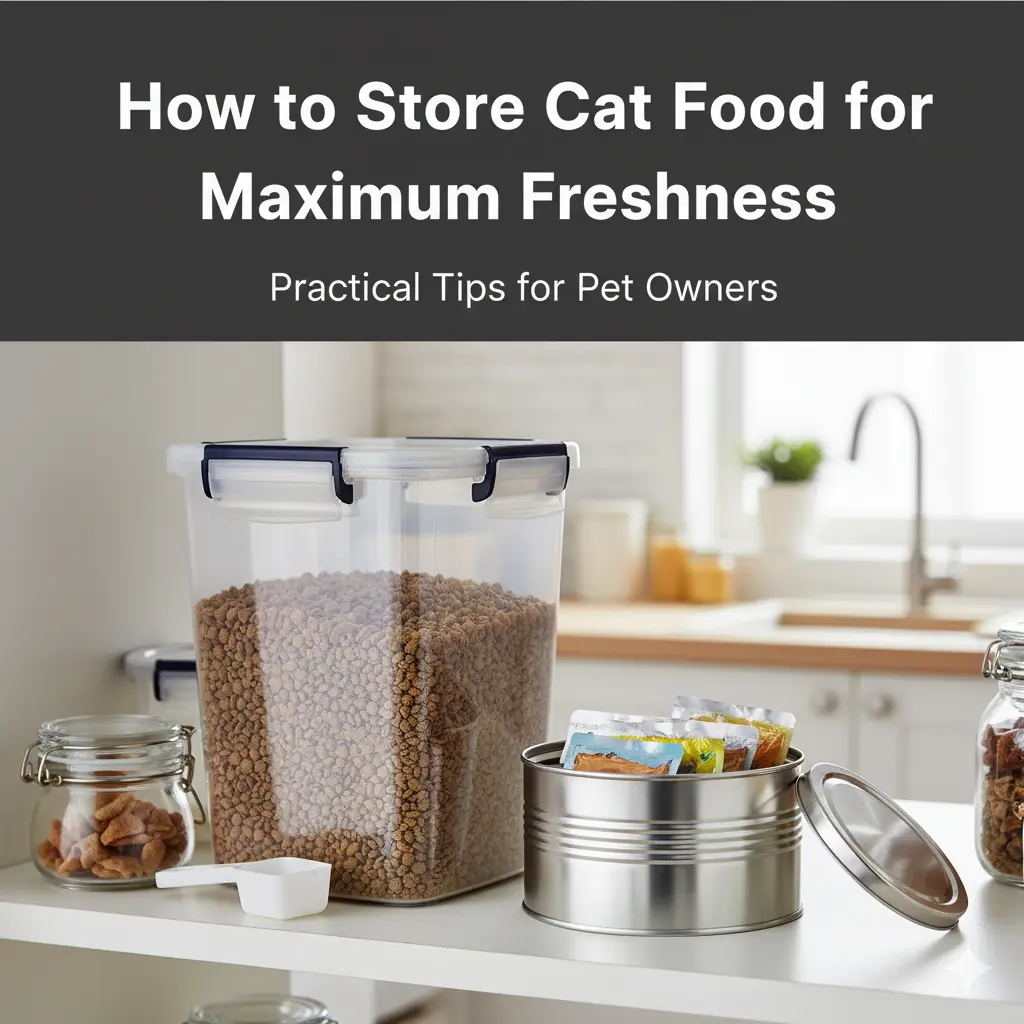Feeding your cat high-quality food is important, but how you store it is just as critical. Improper storage can lead to spoiled nutrients, reduced flavor, and potential health risks for your feline companion. Both dry kibble and wet canned foods are affected by environmental factors such as air, humidity, temperature, and light. Understanding the right storage methods ensures your cat enjoys every meal while reducing waste and unnecessary expenses.

Key Factors That Affect Cat Food Freshness
Air Exposure
Once a bag of dry cat food is opened, contact with air begins a natural oxidation process. The fats in the food can degrade, creating unpleasant odors and taste changes. Cats are highly sensitive to these changes and may refuse to eat food that appears stale to them, even if it seems fine to you.
Temperature and Humidity
Dry food kept in hot or humid environments can lose nutritional quality rapidly. Excessive heat accelerates the breakdown of essential fats, while moisture can cause clumping and mold growth. Maintaining a cool, dry storage area is essential for both safety and flavor.
Light Exposure
Strong light can damage sensitive vitamins such as A, D, and E, gradually reducing the nutritional content of cat food. Using opaque containers and keeping food away from direct sunlight helps preserve both flavor and nutrition.
Container Material
The type of storage container can influence the longevity of cat food. Low-quality plastics can warp, release chemicals, or allow bacteria to form on scratches. Glass or stainless steel containers with airtight seals are the safest options, ensuring food stays fresh longer.
How to Store Dry Cat Food
Dry cat food is convenient and often has a long shelf life, but proper storage is crucial:
- Keep in the original bag: Many packaging designs protect food from air and moisture.
- Seal properly: Fold the top of the bag and secure it with a clip.
- Use an airtight container: For extra protection, place the original bag inside a food-safe container.
- Avoid refrigeration: Moisture in the fridge can lead to mold growth and spoilage.
- Monitor shelf life: Once opened, dry food generally remains fresh for 4–6 weeks if stored correctly.
Proper storage prevents oxidation, nutrient loss, and flavor degradation, keeping your cat eager for every meal.
How to Store Wet (Canned or Pouch) Cat Food
Wet cat food is more perishable and requires careful handling:
- Before opening: Store cans or pouches in a cool, dry, dark place.
- After opening:
- Refrigerate promptly in an airtight container or tightly covered can.
- Use within 48 hours for maximum freshness.
- Do not leave out at room temperature: Bacterial growth can occur rapidly.
- Discard damaged cans: Swollen or dented containers may indicate spoilage and should never be served.
Bringing refrigerated wet food to a slightly warmer temperature before serving can enhance palatability for picky eaters.
Common Mistakes in Cat Food Storage
Mistake 1: Leaving the Bag Open
Air exposure causes fat oxidation and nutrient degradation. Solution: Seal the bag tightly and consider an airtight container.
Mistake 2: Storing in Direct Sunlight or Hot Areas
Heat and light reduce vitamin content and can alter taste. Solution: Store in a cool, shaded, and dry area.
Mistake 3: Using Inappropriate Containers
Thin plastic bags or reused containers can compromise freshness. Solution: Use food-grade glass, stainless steel, or BPA-free plastic containers.
Mistake 4: Ignoring Expiration Dates
Expired food can cause digestive problems. Solution: Always check dates before purchase and label opened packages with the opening date.
Mistake 5: Leaving Wet Food at Room Temperature
Bacteria multiply quickly in opened wet food. Solution: Refrigerate promptly and use within recommended timeframes.
How to Identify Spoiled Cat Food
Check the Smell
Rancid or sour odors indicate fat oxidation. Cats will often refuse to eat food that smells off.
Observe Color and Texture
Dry food: faded color, powdery residue, clumping, or white spots may indicate mold.
Wet food: discoloration, slimy texture, bubbles, or stickiness is a sign of bacterial activity.
Watch Your Cat’s Behavior
If your cat avoids the food or shows unusual eating behavior, it may be a sign of spoilage.
Review Expiration and Storage Time
Even unopened food loses quality over time. Monitor opened packages closely and discard any that exceed recommended storage periods.
Frequently Asked Questions
Q: How long can I use dry food after opening?
A: Stored correctly in a cool, dry, airtight container, dry food lasts 4–6 weeks.
Q: Can dry food be refrigerated?
A: No, the moisture in refrigerators can cause mold. Keep dry food at room temperature.
Q: How should I store cat food during travel?
A: Use small, airtight containers for dry food. Keep wet food unopened in cool bags; avoid transporting opened wet food.
Q: What containers are best?
A: Glass, stainless steel, or rigid BPA-free plastic with airtight lids.
Q: Does original packaging matter?
A: Yes, it is designed to maintain freshness and protect nutrients. Keep it intact when possible.
Conclusion
Proper cat food storage is essential for maintaining freshness, nutrition, and safety. By following these guidelines:
- Seal and protect dry food from air, heat, and light.
- Refrigerate and consume opened wet food within 48 hours.
- Use safe, durable storage containers and maintain hygiene.
- Observe your cat’s eating habits and check for signs of spoilage.
These steps ensure your cat enjoys healthy, flavorful meals every day, reducing waste and avoiding potential health risks.
